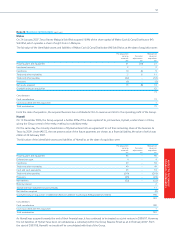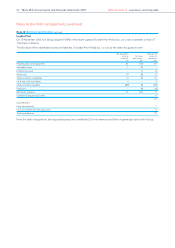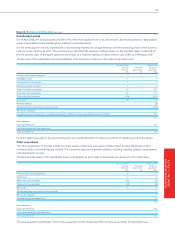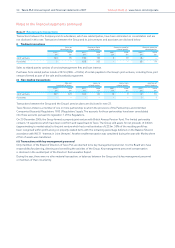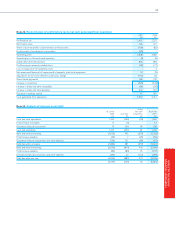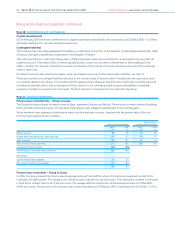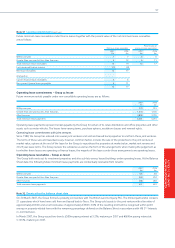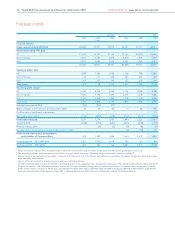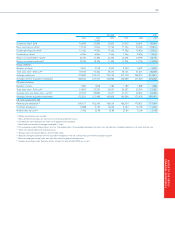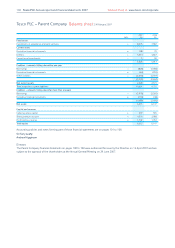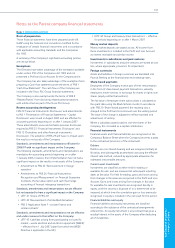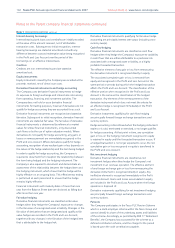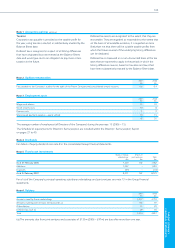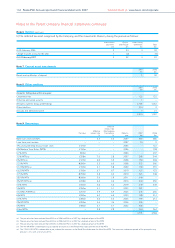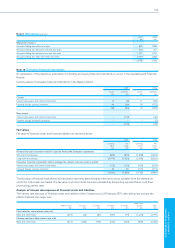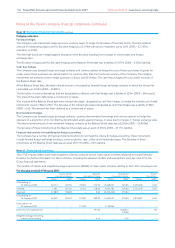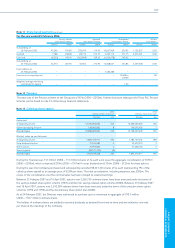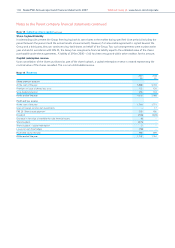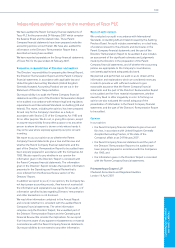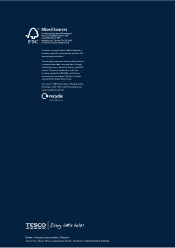Tesco 2007 Annual Report Download - page 103
Download and view the complete annual report
Please find page 103 of the 2007 Tesco annual report below. You can navigate through the pages in the report by either clicking on the pages listed below, or by using the keyword search tool below to find specific information within the annual report.
101
PARENT COMPANY
FINANCIAL STATEMENTS
Notes to the Parent company financial statements
Basis of preparation
These financial statements have been prepared under UK
GAAP using the historical cost convention modified for the
revaluation of certain financial instruments and in accordance
with applicable accounting standards and the Companies
Act 1985.
A summary of the Company’s significant accounting policies
are set out below.
Exemptions
The Directors have taken advantage of the exemption available
under section 230 of the Companies Act 1985 and not
presented a Profit and Loss Account for the Company alone.
The Company has also taken advantage of the exemption from
preparing a Cash flow statement under the terms of FRS 1
‘Cash Flow Statement’. The cash flows of the Company are
included in the Tesco PLC Group financial statements.
The Company is also exempt under the terms of FRS 8
‘Related Parties’ from disclosing related party transactions
with entities that are part of the Tesco PLC Group.
Recent accounting developments
FRS 29 ‘Financial Instruments: Disclosures’ and amendments
to IAS 1 ‘Presentation of Financial Statements – Capital
Disclosures’ were issued in August 2005 and are effective for
accounting periods beginning on or after 1 January 2007.
These amendments revise and enhance previous disclosures
required by FRS 25 ‘Financial Instruments: Disclosures’ and
FRS 13 ‘Derivatives and other financial instruments:
Disclosures’. The adoption of FRS 29 will have no impact upon
the results or net assets of the Company.
Standards, amendments and interpretations effective for
2006/07 with no significant impact on the Company:
The following standards, amendments and interpretations are
mandatory for accounting periods beginning on or after
1 January 2006, however, their implementation has not had a
significant impact on the results or net assets of the Company:
• Amendment to FRS 23 ‘Net investment in foreign
operation’
• Amendments to FRS 26 ‘Financial Instruments:
Recognition and Measurement’ on Financial Guarantee
Contracts, the fair value option and cash flow hedge
accounting of forecast intragroup transactions
Standards, amendments and interpretations not yet effective
but not expected to have a significant impact on the Company:
• UITF 41 ‘Scope of FRS 20’
• UITF 42 ‘Reassessment of embedded derivatives’
• FRS 5 ‘Application Note F – private finance and
similar contracts’
Standards, amendments and interpretations not yet effective
and under review as to their effect on the Company:
• UITF 45 ‘Liabilities arising from participating in a specific
market – waste electrical and electronic equipment (WEEE)’
– effective from 1 July 2007 (date from which the WEEE
Directive is applicable in the UK)
• UITF 44 ‘Group and treasury share transactions’ – effective
for periods beginning on or after 1 March 2007
Money market deposits
Money market deposits are stated at cost. All income from
these investments is included in the Profit and Loss Account
as interest receivable and similar income.
Investments in subsidiaries and joint ventures
Investments in subsidiaries and joint ventures are stated at cost
less, where appropriate, provisions for impairment.
Foreign currencies
Assets and liabilities in foreign currencies are translated into
Pounds Sterling at the financial year end exchange rates.
Share-based payments
Employees of the Company receive part of their remuneration
in the form of share-based payment transactions, whereby
employees render services in exchange for shares or rights over
shares (equity-settled transactions).
The fair value of employee share option plans is calculated at
the grant date using the Black-Scholes model. In accordance
with FRS 20 ‘Share-based payment’ the resulting cost is
charged to the Profit and Loss Account over the vesting period.
The value of the charge is adjusted to reflect expected and
actual levels of vesting.
Where a subsidiary awards options over the shares of the
Company, this is treated as a capital contribution.
Financial instruments
Financial assets and financial liabilities are recognised on the
Company’s Balance Sheet when the Company becomes a party
to the contractual provisions of the instrument.
Debtors
Debtors are non interest-bearing and are recognised initially at
fair value, and subsequently at amortised cost using the effective
interest rate method, reduced by appropriate allowances for
estimated irrecoverable amounts.
Current asset investments
Investments are classified as either held for trading or
available-for-sale, and are measured at subsequent reporting
dates at fair value. For held for trading, gains and losses arising
from changes in fair value are recognised in the Profit and Loss
Account. Gains and losses arising from changes in fair value
for available-for-sale investments are recognised directly in
equity, until the security is disposed of or is determined to be
impaired; at which time the cumulative gain or loss previously
recognised in equity is included in the net result for the period.
Financial liabilities and equity
Financial liabilities and equity instruments are classified
according to the substance of the contractual arrangements
entered into. An equity instrument is any contract that gives a
residual interest in the assets of the Company after deducting
all of its liabilities.
Note 1 Accounting policies


